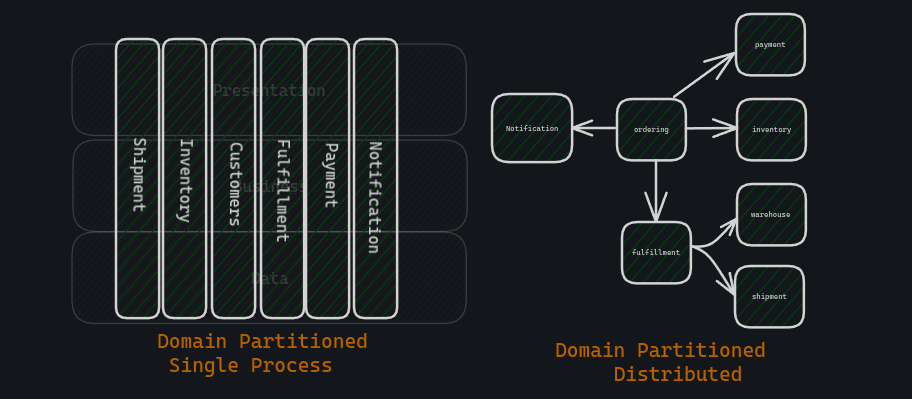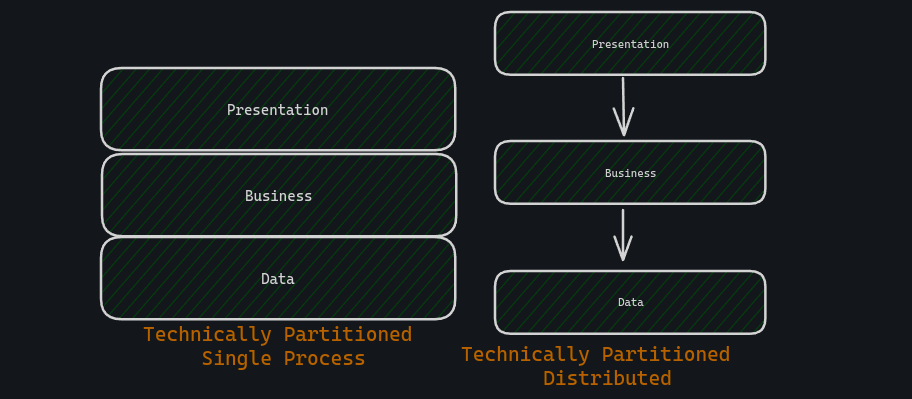Distributed or Single Process Link to heading

Single Process Application: A self-contained program that executes on a single computer. It handles all its processing tasks, data storage, and retrieval using the local machine’s resources (memory and storage). Examples include offline games and mobile apps without network functionality.
Distributed System: A software program designed to function across multiple computers connected over a network. These applications are broken down into smaller components that run on different machines. These components communicate with each other to achieve a common goal.
A basic distributed system can consist of just two components like a Backend API and a Database.
A microservices architecture is a more complex form of a distributed system. Here, the application is broken down into many smaller, independently deployable services, each with a specific function. These services communicate with each other using well-defined APIs.
Domain Partitoning Link to heading

The application is divided into modules or components, each aligned with a specific business subdomain. This means modules are responsible for the functionality and data related to their assigned subdomain.
Example:
Imagine an e-commerce application. Domain partitioning could create separate modules for:
- Product Catalog: Manages product information, images, and descriptions.
- Shopping Cart: Handles adding and removing items from the cart, calculating totals, and applying promotions.
- Payment Processing: Securely processes customer payments and interacts with payment gateways.
- Order Fulfillment: Tracks orders, manages shipping, and interacts with shipping carriers.
- Customer Account Management: Allows customers to create accounts, manage profiles, and track order history.
Implementation Styles:
Domain partitioning can be implemented in different ways depending on the overall architecture of your application:
-
Distributed Systems (Microservices): In microservices, each domain partition becomes a separate, independent service. These services run on their own processes, potentially on different machines, and communicate with each other via APIs.
-
Single Process (Modular Monolith): Even within a single process application (monolith), domain partitioning can be beneficial. The application code can be organized into modules that align with business subdomains.
Technical Partitioning Link to heading
 Unlike domain partitioning, which focuses on business functionalities, technical partitioning divides the system based on technical characteristics.
Unlike domain partitioning, which focuses on business functionalities, technical partitioning divides the system based on technical characteristics.
Imagine a web application for managing customer accounts. Technical partitioning could create separate layers:
- Presentation Layer: Handles the web user interface for creating, editing, and viewing customer accounts.
- Business Logic Layer: Contains the application logic for validating user input, processing account information, and interacting with the data layer.
- Data Access Layer: Talks to the database to store and retrieve customer account data.
Implementation Styles:
Similar to domain partitioning, technical partitioning can be applied in both distributed and single-process applications:
-
Distributed Systems: In a distributed system, each technical layer could be implemented as a separate service running on its own process.
-
Single Process Applications: Even within a single process, technical layers can be used to organize the codebase around technical concerns.
Monolith Link to heading
I avoided using the word “monolith” because it can refer to both single-process and distributed applications. As long as application components cannot be deployed independently, they exhibit characteristics of a monolithic architecture. The common term used to describe such applications is a two-tier or three-tier architecture.